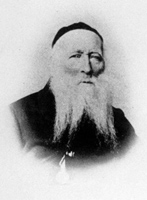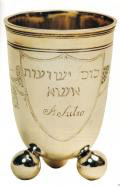| The first Jews of Dorsten |

In 1932 a newspaper article reported that in the
13th century there were already Jews in Dorsten. It said: „They
were wealthy, respected and very religious.” But up to now
we have not been able to confirm this first evidence of Jews in
Dorsten. Despite the fact that the Jews were very much liked by
their fellow citizens, in the 16th century the bishop in Münster
ordered officials to drive away all Jews from the diocese of Münster.
In the following years entry permits were only rarely granted. In
1628 there was a plot of land that was called the „Jewish
field”. In 1790/91 this plot was called the „Jewish
graveyard”. Records show that in 1815 a burial took place
there. There are not many records for the time before 1800.
In1808 the first Jews received permission to settle
and establish businesses in Dorsten. It was the 45-year-old butcher
David Moyses from Wesel, who later took the name Perlstein, and
43-year-old Michel Samuel from Muelheim/Ruhr, also a butcher, who
later took the name Grünebaum.


Saveguard certificate of the
Bishop of Muenster for the Jews of his territory (1784)

From 1810-1812 five more families followed including
the merchant Samson Nathan (Eisendrath), 37 years old, from nearby
Haltern. Within four to five years a small Jewish community consisting
of eight families formed in Dorsten. This small community did not
only have the problems of existing that come when something new
is established, but these problems were particularly bad in an atmoshphere
in which Jews were not only regarded as „strangers”
but in this small, strictly Catholic town also as religious outsiders.
The everyday language of the Dorsten Jews was Yiddish,
so-called „Jewish German”, as letters from this time
in incomprehensible German show. Two parties soon formed in Dorsten:
on the one hand there were the „progressives” with Samson
Nathan Eisendrath and on the other the orthodox or „zealots”
to which the founders of the community belonged: David Moyses Perlstein
and Michel Samuel Grünebaum.
From 1808 the men met in a prayer room, set up
as prescribed, which they called „synagogue”. The warden
was the merchant David Moyses. But at Easter 1820 Samson Nathan’s
group also organised their own room which they called „synagogue”.
This split, caused by a dispute between orthodox and progressive
Jews, brought the danger of the community breaking up completely
as even before the synagogue dispute, minions never came about because
the prescribed quorum of ten men was not achieved. There were only
eight men who for prayer depended on the participation of men from
outside. As a result of the split there were only four men in each
of the conflicting groups.
Samson Nathan Eisendrath enjoyed importance and
a voice in the small community in which from 1817 he was the synagogue
warden. But times were difficult. Tradition was no longer taken
for granted: the slowly progressing emancipation of the Jews led
to changes which questioned the past and present concept of the
community.
 |
|
It was too difficult for the Mayor of Dorsten, Mr. Gahlen,
to mediate and he called on the regional rabbi Abraham Sutro
of Münster. As there had now been „assaults and
even in the synagogue” Abraham Sutro went to Dorsten.
But his attempts at mediation failed.
(Portrait of Rabbi Abraham Sutro (1784-1869))
|
It was only with the Prussian law of 23 July 1847,
which stated that every Jew had to belong to the community and pay
taxes, which amounted to a certain percentage of his income, that
the Jewish community of Dorsten was able to develop a working administration.
It remained orthodox. It is not known, however, whether the many
years of conflict were connected with the general religious differences
among German Jewry.
After the introduction of compulsory education
in Prussia, the authorities made sure that Jewish children also
received proper schooling. They were allowed to attend lessons at
Christian schools if Jewish communities were unable to set up their
own schools. But the Jewish community was responsible for religious
education.
 |
|
In 1820 Rabbi Sutro had already demanded that a Jewish
community teacher be employed for the children of the eight
Jewish families in Dorsten. However they refused to pay for
the teacher’s salary and food because most of them were
poor. After a dispute lasting three years, the following was
agreed on: With the help of two house and family fathers,
who were to be elected, Samson Nathan Eisendrath was appointed
to engage a teacher, collect school fees and decide on the
order in which families would take it in turns to provide
accommodation and food for the teacher.
(Havdala goblet belonging A. Sutro)
|
But in the next twenty years there were still problems
in the Dorsten community and things finally came to a head on 14
April 1844 when Samson Nathan Eisendrath resigned from the position
which he had held for 27 years. Unfortunately no precise reasons
for this can be found but probably the conflict between the „law-abiding”
Jews and the „modernisers” had escalated. Three years
later, on 23 April 1847, Eisendrath told the community that he was
leaving the synagogue community. „I hereby announce that I
and my four sons David, Moses, Cosmann & Osea (Oscar/Asser)
are leaving the local Jewish church”. He and his sons still
wanted to attend synagogue but „voluntarily” when they
wanted to without them being counted on to form a minion.
Internal disputes were probably the reason for
his leaving the synagogue. Eisendrath was accused of having refused
to supply reports and accounts on income and expenditure and allegedly
„taking home without authority” the torah scroll acquired
by him.
As warden and treasurer Eisendrath was also responsible
for the wordly affairs of the community. He was, for example, responsible
for the finances of the community which was so poor that contributions
often did not cover expenses. He was also responsible for the negotiations
with the Marks-Haindorf-Foundation in Münster, an „Association
for the Promotion of Jewish Artisans and the Establishment of a
School”. Eisendrath endeavoured to establish apprenticeships
for young Jews.
In December 1869 the Jewish community acquired
a house at 24 Wiesen Strasse that had belonged to its members Moses
Hess and Moises Eisendrath. The four-axis timber-framed house located
on a 2625 square foot plot of land was built in the 18th century
and was just like any other normal house. The house first had green
plastering and from 1920 white plastering. Over the front door there
was a Star of David. The right-hand side of the house was always
let to non-Jews. On 23 March 1945 this house in Wiesen Strasse was
hit by a bomb and completely destroyed.
In the later part of the 19th century and with
more and more Jews from Dorsten emigrating, the Dorsten community
grew smaller and smaller and less and less important. From around
the turn of the century the emerging communities in the Ruhr such
as Gelsenkirchen, Gladbeck and Bottrop were regarded as much more
attractive than rural Dorsten. In 1925 the Jewish community in Dorsten
only had 25 members; in 1932 there were 47 members. In 1932 its
status as a central synagogue community was lifted and it was decided
to separate the communities of Buer, Horst, Westerholt, Gladbeck,
Bottrop and Osterfeld.
On 23 January 1942 the last 12 Jewish citizens
of Dorsten were deported to the Riga ghetto. That was the end of
the Jewish community in Dorsten – up to today.
|